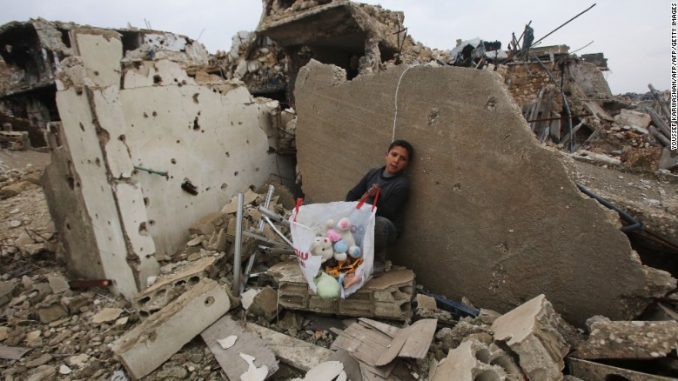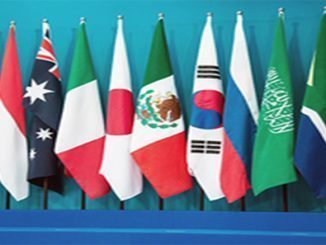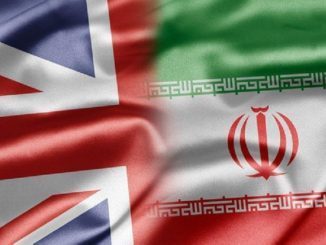
In a new chapter of the humanitarian crisis in Aleppo, a new deal was reached to resume the evacuation of thousands of stranded civilians and fighters in besieged east Aleppo in return for evacuation of Shiite civilians from rebel-besieged towns in Idlib, after two previous agreements have collapsed.
After months of crippling siege, starvation policy, daily bombardment, fierce clashes and bloody massacres the Assad regime and its allies were able to oblige the rebels in Aleppo to surrender and make an agreement to leave the area they have been holding since 2012 after losing more than 90% of it.
The ceasefire agreement was a result of talks between Russia and Turkey.
As part of an agreement between Turkey and Russia, tens of thousands of rebels and civilians were supposed to be evacuated from eastern Aleppo to rebel-held Idlib, allowing the Assad regime to take full control of the city after years of fighting.
By taking full control of Aleppo, Assad has proved the power of his military coalition, aided by Russia’s air force and an array of Shi’ite militias backed by Iran after his rule was close to ending after major losses in 2015.
Previous failed deals
On Wednesday morning, buses and ambulances were brought to evacuate rebel fighters and their families – only to be turned away shortly afterward as the ceasefire fell apart and the bombardment was resumed again.
However, the bombardment stopped at night and the agreement was resumed to evacuate the rebels and civilians on Thursday.
The civilians evacuation was continued until Friday morning when the convoy was obstructed by Iranian-backed militias again, who refused the agreement and sought to force their conditions on its progress.
Iran was insisting people be allowed to leave two besieged Shi’ite villages before letting the Aleppo evacuation happen.
Four people who were part of a convoy evacuating the besieged districts of east Aleppo were killed by Syrian government forces.
Numerous rebels and east Aleppo residents shared reports and videos of people fleeing the sound of shooting, being detained and returning home badly beaten and robbed of their possessions near a checkpoint as they tried to leave the city on Friday.
The civilians then returned to Aleppo, where the reports say that up to 50,000 people remained stranded there ahead of the evacuation, including about 4,000 fighters and about 10,000 family members of fighters.
This is what the #Assad And Shia militants do to the innocent people who's been evacuated from #Aleppo
Damn on this World They're civilians pic.twitter.com/13pUtMbW42— Ahmad Alkhatib (@AhmadAlkhtiib) December 16, 2016
This'd what happened yesterday when civilian were getting ready to be evacuated,In #Aleppo only civilian are being killed even while a truce pic.twitter.com/l1knD08Z16
— Zouhir_AlShimale (@ZouhirAlShimale) December 17, 2016
Read more: Iran plays dominance game, suspends civilians evacuation in Aleppo
A new deal reached
A new deal was reached on Saturday to allow the civilian evacuation on Sunday, in return for evacuation of people from rebel-besieged towns.
Buses started entering several neighborhoods on Sunday under the supervision of the Red Crescent and the International Committee of the Red Cross (ICRC), state news agency SANA said.
After negotiations, agreement finally reached: civilian evacuations should begin in Aleppo, Zabadani, Madaya, Kafraya & Fooa w/in hours.
— هادي العبدالله Hadi (@HadiAlabdallah) December 17, 2016
Sources in Aleppo said that as part of the latest deal, a total of 4,000 people will evacuate the Shia-majority towns of Fua and Kefraya in Idlib province, which are currently besieged by opposition fighters.
The source, who wanted to remain anonymous, said 1,500 people in the government-besieged towns of Madaya and Zabadani as well as everyone in eastern Aleppo will also be allowed to evacuate as part of this deal.
Syrian state media reported that government forces would only allow civilians and fighters to leave eastern Aleppo once families in Fua and Kefraya are evacuated.
Mohammed Shakiel Shabir, an aid worker based in rebel-held Idlib province, said approximately 100 buses were being prepared to collect the civilians from Khan al-Asl, a suburb of Aleppo city.
“We are taking several ambulances, food and medicines and approximately 100 coaches to Khan al-Asl,” he told Al Jazeera.
“Each coach can transport around 40 people so [God willing] we will be transferring thousands to safety.”
Lot of people are waiting in the streets since Friday at the closed unsafe passage, no place to go in the city of death #Aleppo pic.twitter.com/M5AkyxR18q
— Lina shamy (@Linashamy) December 18, 2016
We will return someday #Aleppo pic.twitter.com/GuRB23mffB
— Ahmad Alkhatib (@AhmadAlkhtiib) December 15, 2016
The Iranian-backed Shi’ite militias have played a leading role in the siege of rebel-held Aleppo and in the Syrian army’s retaking of near full control of the city, and will not leave a “victory” like this be passed without using it to achieve their goals and changing the city’s face and increase their dominance.
“Russia has failed to restrain the sectarian Shi’ite militias in Aleppo to complete the deal and Moscow should abide by its commitments,” Sayal said.
“There are still civilians in Aleppo who need to be evacuated in harsh weather conditions and Russian statements that besieged Aleppo is empty is absolving itself from following up on the agreement,” he added.
“It’s clear the Iranians have a different opinion here … I think they believe that they are winning and must finish off the opposition, rather than allow them to leave the city alive. The Syrian regime seems to be closer to the Iranian position,” an analyst said.
????
Left: Moshe Dayan in #Alquds 1967.
Right: #Soleimani in #Aleppo 2016. @khamenei_ir regime will pay the price. Invaders always do ?? pic.twitter.com/Iw8nVsTm5A— Dr. Ali Bakeer (@AliBakeer) December 17, 2016
Iran’s strategy in Syria
Iran and the Syrian government do not want to compromise on the battlefield or at the negotiating table, believing that total domination will give them a better hand to shape the aftermath. Russia, on the other hand, sees a benefit in transitioning from bludgeoning superpower to peace-broker.
Shia militias have also played a decisive role. Raised by Iran’s Revolutionary Guards, the militias have been far more effective than Syrian units. Their numbers had built around east Aleppo since early last year to an estimated force of 6,000-8,000 troops, many of them battle-hardened in Iraq or southern Lebanon.
The militias report to the Iranian Maj Gen Qassem Suleimani, who was tasked more than a decade ago by the supreme leader, Ayatollah Khamenei, to export the values of the Islamic Revolution into the Arab world. Suleimani’s Quds Force is one of the Guards’ most elite units, attracting ideological cadres who believe in Shia supremacy.
Under Suleimani’s control are several Iraqi units, Asa’ib ahl al-Haq, Abu al-Fadhil al-Abbas, and the Nujaba Front, which is affiliated with the Keta’ib Hezbollah militia. All are power players in Iraq’s political-military sphere. Lebanese Hezbollah plays the same role in Beirut and southern Lebanon, where it is interwoven into the political and security apparatus.
Hezbollah was the first of the Iranian proxies to join the fight alongside Assad, followed by Shiite Iraqi fighters and Afghan refugees in Iran, recruited on the promise that their families would gain the right to reside in Iran.
The blood and treasure expended by Iran has focused on Aleppo and the western suburbs of Damascus, the site of the Zainab shrine – a pilgrimage point for Shia Muslims. Controlling these two areas would ensure Iran’s grip on the biggest areas in Syria and will be a huge step in changing Syria’s demographics to serve is own agendas.
Iran has framed its war effort in sectarian terms, insisting the men it has sent to fight are in Syria to defend the shrine from “Sunni extremists”. In addresses inside Syria, Akram al-Ka’abi, the leader of the Nujaba Front, has exhorted his followers to seek revenge for battlefield losses to Sunni figures in the founding years of Islam.
The fate of rebel-held Aleppo spells the abject failure of the west’s contradictory and piecemeal policies. It is a humiliation for the UN. Its fall will be an unequivocal victory for Russian strategy, and the shameful and humiliating defeat for all those who said they stand with the civilians and left them to face annihilation including US, Turkey and all Arab states.




